The forgotten scandal of the starving horses.
In 1975 I found myself starting a new job as Chief Inspector of the Bahamas Humane Society in Nassau. I had no idea that soon after my arrival I would be sitting alone in a derelict stable at the iconic Hobby Horse Hall Racetrack awaiting help, cradling the grotesquely grimacing head of a skeletal dying horse named Last Hope in my lap.
Before arriving in the Bahamas I had been informed that I was expected to regularly inspect the racetrack stables and I had foolishly envisaged that in a rich man’s paradise it would be a professional operation on par perhaps with the likes of Newmarket in the U.K or Churchill Downs in the U.S. I could not have been more wrong because I had I arrived during the demise of the once famous and iconic Hobby Horse Hall where hundreds of horses suffered, and many died horrible deaths. The Government, Racing Commission and Horse Owners Association were all aware of the situation but chose not to do anything.

Brief History
The racetrack was constructed in the 1930s opposite Cable Beach where the Baha Mar resort now stands and for nearly 40 years proved very popular. It had many ups and downs like a major fire in February 1958 which destroyed most of the facilities, but by 1960 a new grandstand and parade ring were built and state of the art starting gates and photo finish cameras were installed. It became the haunt of the rich colonial elite who mingled with the famous such as the likes of Errol Flynn and they enjoyed charcoal grilled lobster, turtle pie and steaks on the dining terrace while watching top jockeys and horses some from Miami. It had such a colourful social scene that the press eagerly wrote society columns about the meetings, publishing photographs of the celebrities, the fashion and the hats worn by the ladies.

So when I first visited the track in early October 1975 I was expecting great things and was fascinated to be following in the footsteps of Errol Flynn and his ilk, but nothing could have prepared me for the sights I witnessed over the next two years.
Leaving horses to starve was accepted practice.
The racing season stretched from February to the end of May when there could be could be upward of 300 horses on the site and officially they all had to be removed by the 1st. June when electricity and water supplies were turned off. The reality, I soon discovered, was that only the thoroughbreds and breeding mares were taken while the the luckier ones of those left behind were let loose to wander the island to fend for themselves. The unlucky ones risked starvation at the track or were just locked in a stable to die an awful death. It was accepted practice and no one seemed to care. Owners had been hit by soaring feed prices which had tripled over the previous two years and couldn’t afford to look after them when racing stopped.

It is exceedingly difficult to describe adequately what happened behind the scenes in the track’s last few years without it appearing totally exaggerated. The yard consisted of fifteen or so long wooden stable blocks and a couple of more sturdy brick ones in various states of dilapidation. Some buildings were covered in graffiti or painted murals. Nearly every stable door was damaged either by chewing or rot and most walls had planks missing or ragged holes in them. There was a thick haze and smell of marijuana permeating the whole place with a handful of stable lads sitting around, many obviously under the influence. Piles of dung littered the place along with beer cans and bottles, debris and abandoned vehicles. Pathetic looking half-starved horses wandered loose through the debris with protruding ribs and sunken backs. I could not believe what I was seeing.
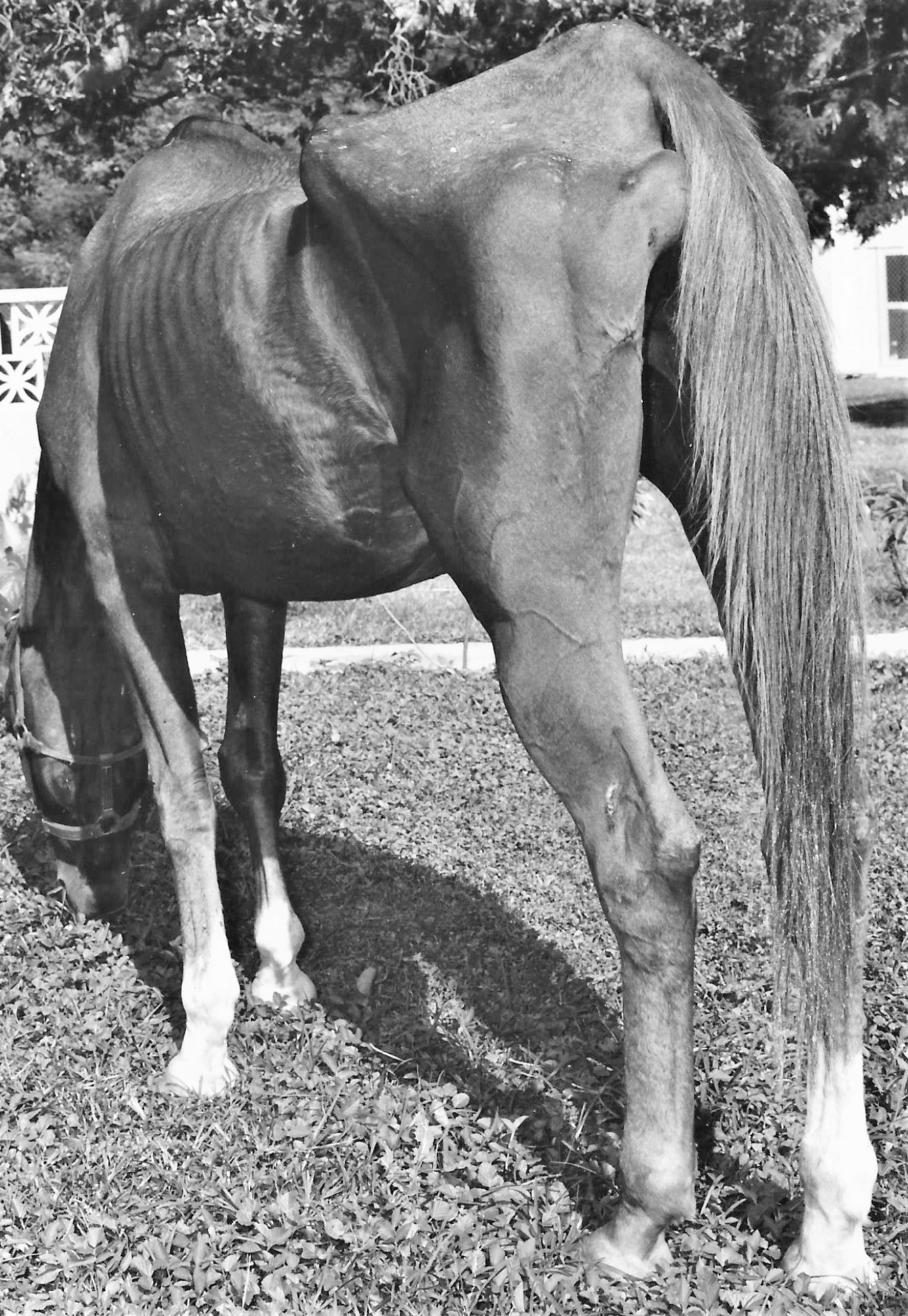
Horses vied with hordes of huge brazen rats when feed buckets were placed in front of them. They appeared from everywhere with little fear of humans and when the horses tried to force their heads into the buckets they were bitten and had to back off to wait until the rats had finished. Mares would often die giving birth and I would find their bodies dumped and covered in flies. The situation was so bad that it became necessary for me to visit at least every other day to satisfy myself there were no horses starving to death so that I could sleep at night. I would find them wandering all over the island and was constantly called out to attend to those that had been involved in road accidents, collapsed by the roadside through weakness or had fallen down abandoned wells.
It should have been a national scandal.
There was much talk of races being allegedly “fixed” or contrived with “Ringers” appearing under false names and old nags put in as “fillers” to make up the numbers alongside the thoroughbred preordained winners. There were stories that each owner or trainer of a stable allegedly took turns to win races to spread the prize money out fairly. Stable lads openly admitted that horses were drugged and made weak by not feeding or exercising them. During the season I found horses with weeping abscesses on their necks probably caused by dirty needles and I sometimes found discarded drug vials which seemed to collaborate the stories.
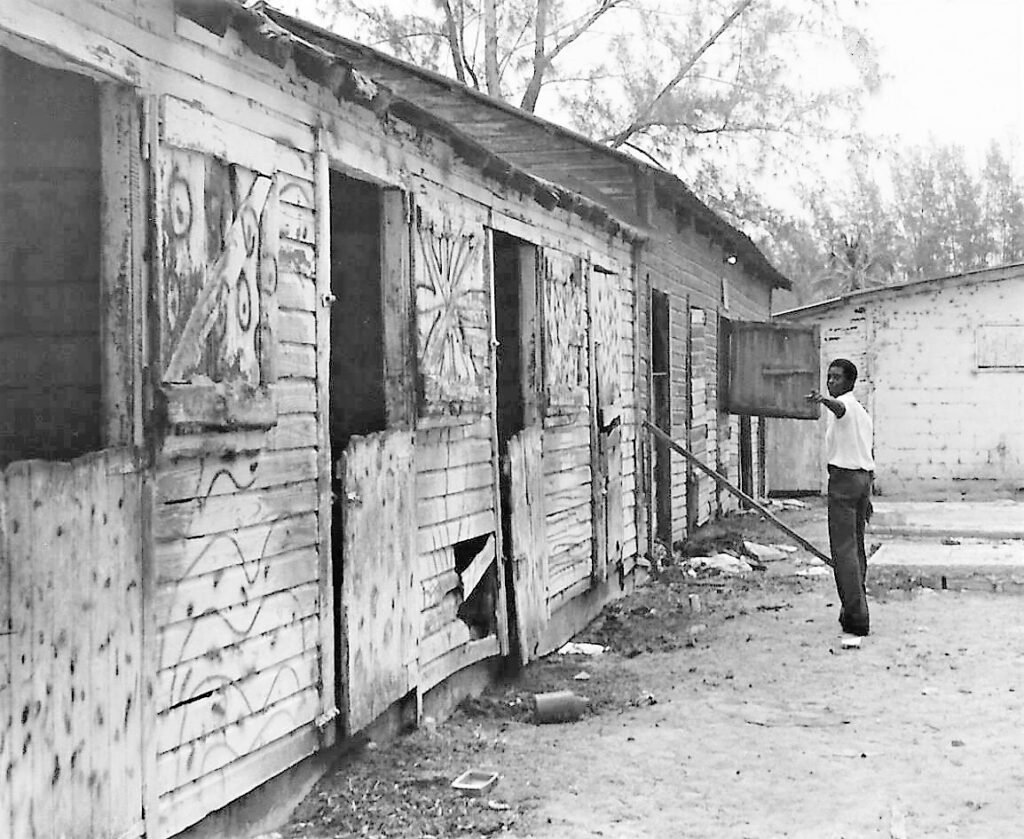
Often when eight or nine horses were listed to run a race several never made it to the starting gate as there weren’t enough fit horses to be found that could complete the circuit without dropping dead halfway round. It was not unknown for the thoroughbreds to do exactly that as in the case of Sir Mark in the “Horse of the Year race” which dropped dead two yards after passing the winning post to much publicity. Cause of death unknown. Gambling syndicates and those “in the know” no doubt made a lot of money.
The whole Nassau race operation should have been a national scandal but surprisingly few people seemed to care about the situation. The suspect “goings on” appeared to be common knowledge with one regular racegoer writing a letter to the editor of the main Nassau newspaper which included:
“I followed the 1975 season from beginning to end and sad to say it was very disappointing to the public and many patrons of the track expressed such sadness. If Mr Bastian [new racetrack director] is to do an honest job with the public in mind then he must make certain that the races are competitive and not given races i.e. races that are so made up for particular horse to win or the stable to win. Neither should a programme be made up to show nine horses in the race when in fact there only six honest entries. The proper thing to do is to run six horses and the public not be cheated out of three.” [John Leon Rolle, Letter to Editor, Nassau Guardian 1975]
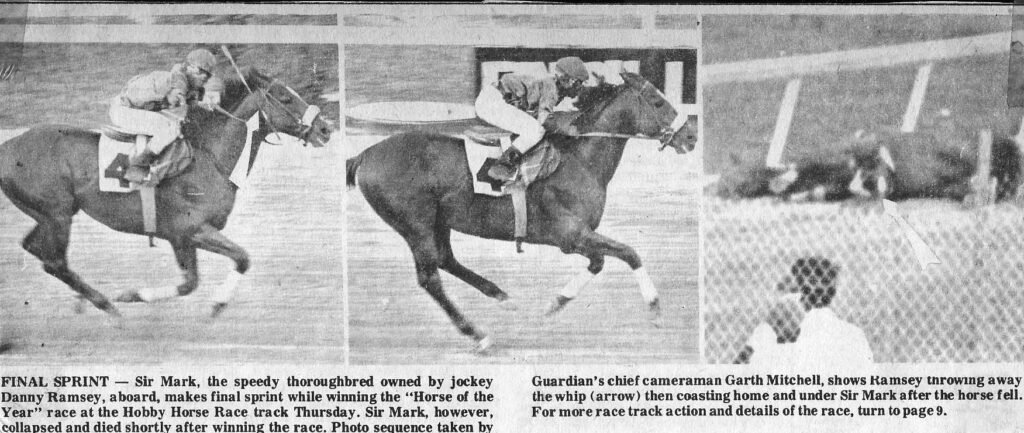
This then was the famous and iconic hallowed national racetrack of the Bahamas situated only a matter of yards from luxury hotels like the Ambassador Beach directly opposite and their tourist residents.
I decide to try and close the track.
It was obvious that I could not stand by like everyone else and ignore all the suffering and death being caused to the horses and so I decided it was my mission to try and close the track. I was soon put on my guard by the young local racetrack veterinarian Dr Balfe who warned me to “watch your back”, as he had been assaulted for trying to intervene. His warning was not without truth as I found out a few months later.
As the months went by I had to attend to a constant stream of emaciated, injured and uncared for horses both at the track and around the island, many of which we managed to put back to health but some I sadly had to shoot. In the first twelve months I aided 39 horses and had to shoot a further ten. Some of the ones we restored to health and found new homes were stolen back as it was difficult to keep their location hidden on a small island all of which was depressing and disheartening.
I did my best to be a nuisance to officialdom and horses owners taking what proved to be futile prosecutions and took every opportunity to give the track bad publicity with the help of the Nassau Guardian and the Tribune newspapers. They ran many front-page graphic stories using photographs that I supplied them.
I begin to receive threats
Eventually I began to receive both veiled and actual threats including a group of drunken lads who turned up at the Bahamas Humane Society one afternoon brandishing cutlasses and wanting a word with me, but luckily I was out on my rounds. Soon after another group arrived late one evening outside my house banging their cutlasses on my front garden wall shouting that they were going to chop me up. I went through a period of slight concern but being young I thought I was invincible and I found it all a little surreal. My employers took it more seriously and were worried to the point of putting iron bars on my bedroom window – ornate ones I might add. From then on, I never went to the track at night or during the day without my dog Condor and a fellow inspector.

What happened to Last Hope
As regards Last Hope the poor horse I mentioned at the beginning, I remained alone with her for nearly an hour awaiting help and it was the closest I have come to any kind of spiritual or ethereal experience, sitting there in the stillness and gloom of the stable with just the sound of her shallow breathing. It was an event so awful that it has haunted me for most of my life and ranks amongst the worst cases of animal cruelty I ever experienced. It was the thought of the suffering and hopelessness she must have gone through and her grotesque skeletal appearance that affected me the most, particularly the sight of her tightly drawn face revealing her teeth in an agony death mask grimace. I could not believe she was still clinging onto life.
While I awaited our veterinarian, I found myself praying and encouraging her to hang on although I expected she would have to be destroyed, but after an examination our vet thought she had a very slim chance of survival if I wanted to give it a try and of course I did. He reckoned she had not eaten or drunk for at least two weeks and was lucky to have survived that long. She underwent a feeding and treatment regime and was miraculously back on her feet after a couple of days and started putting some weight on and slowly improved, helped by all the kindness of the many well-wishers among the staff and volunteers. I found out later that she had suffered losing a foal a couple of months previously to add to her woes.
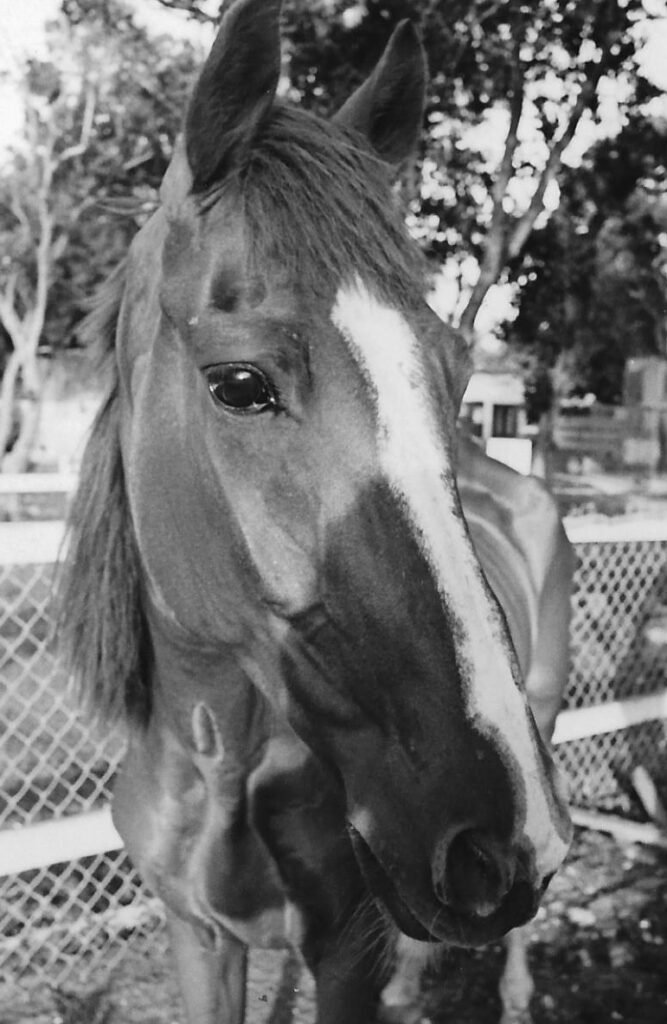
I spent as much time as I could with her, but tragically she started going downhill after several weeks and died, her internal organs probably having been weakened too much. We were all upset, particularly me. The only compensation was that she experienced much love and care in those last few weeks of life.
I was determined to find her callous owner and eventually did. He was bemused at my outrage and laughed off any mention of prosecuting him as such an event had never happened before, but after a struggle I did get him charged. He pleaded guilty and was fined the maximum $50 (£25) for the offence under a completely outdated and farcical colonial animal cruelty law. A waste of time perhaps but I wanted to make a point and it kicked started bad publicity for the track and my campaign to close it. But I passionately believed I owed Last Hope some justice for her suffering.
The end in sight
A company called Raceco Ltd owned the track and were not investing any money into it as they were in talks to sell the land to the Government to build a hotel and casino complex though this didn’t happen for another two years. Meanwhile the carnage continued with neither the Racing Commision or Government taking any action for the welfare of the horses.
The Government spokesman Cyril Stevenson commented: “we cannot take responsibility for these horses as they are privately owned. Nobody likes to see horses starving to death, but there is nothing we can do”.
Mr Wellington Ferguson, Head, Bahamas Horse Owners Association stated: “several owners have been starving their horses in protest [at the track closing]. Others just cannot afford to look after their animals. We cannot take responsibility for these horses starving to death, there is nothing we can do”.
Postscript
After its closure some of the horses were airlifted to Miami to be found new homes, paid for by American charities. I visited the track just after it was abandoned awaiting demolition and wandered the empty overgrown stable yard now mercifully free of suffering horses and wondered if it had all been a horrible dream. I can still remember many of the horse’s names that I helped: Spanish Dancer, Strange Girl, Troublemaker, Royal Order, Air Queen, Hang Em High, Hot love II, Last Sight and Connie.
The hotel complex has obliterated all trace of the track except for a small nature reserve which bears its name, but there is no memorial to all those poor horses that suffered the unforgivable abject cruelty. For some inexplicable reason there is much misplaced nostalgia for the place as it was a shameful episode in Bahamian history at the end.
For a more detailed account use this link – You will be redirected to a Microsoft SWAY document.
The race track may be gone but the Bahamas Humane Society continues to battle cruelty forty years on and is always in need of support. Click on the icon below to donate and for more information.
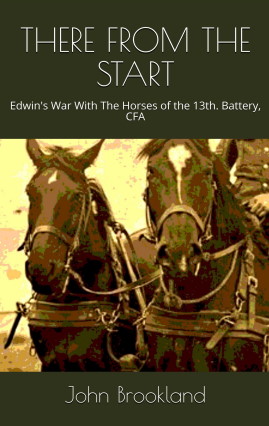
Not just another military history. £10.99
Describes the intense emotional relationship between the WW1 artillery drivers and their war horses from the perspective of Gunner Edwin Clarke who served for nearly four years on the western front. The men relied on the horses as much as the horses on them. They slept, fought and died together.

